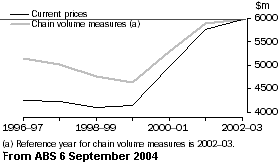|
News & Views item - September
2004 |
 Decline
of Business Expenditure on R&D (BERD) as a Share of GDP Disturbing:
FASTS (September 6, 2004)
Decline
of Business Expenditure on R&D (BERD) as a Share of GDP Disturbing:
FASTS (September 6, 2004)
 The
President of the Federation of Australian Scientific and Technological Societies
(FASTS), Professor Snow Barlow, said the decline in BERD as a percentage of GDP
was a disturbing result particularly in view of the buoyant state of the
national economy.
The
President of the Federation of Australian Scientific and Technological Societies
(FASTS), Professor Snow Barlow, said the decline in BERD as a percentage of GDP
was a disturbing result particularly in view of the buoyant state of the
national economy.
Quoting from the latest ABS
tabulation on Business Expenditure on
Research and Development (BERD) released today Professor Barlow
pointed to a BERD decline as a percentage of GDP from 0.81% in 2001/2 to 0.79%
in 2002/3.
"While BERD increased by 3.6% in 2002/3 - or 1.5% in real terms* - the decline
as a percentage of GDP raises serious concerns about how much of today's
economic activity Australia is prepared to invest in the future."
What is in fact the almost complete flattening of the chain volume measure from
2001-02 to 2002-03 demonstrates virtually no increase in constant dollars
let alone an increase as a percentage of GDP as compared to the previous marked
overall revival in BERD.
Professor Barlow went on, "Australia's national investment in R&D is declining
relative to OECD averages and today's ABS figures confirm the gap is widening.
Australia's strong GDP growth is not sustainable while Australia's national
investment in R&D continues to decline as a percentage of GDP. With the
impending retirement of the 'Baby-boomer generation', future growth must come
from new knowledge generated from R&D and innovation.
"Governments cannot simply rely on record consumer spending
to underpin GDP growth. For 14 years Australia's strong economic growth has been
built on financial and labour market reforms but there are diminishing returns
with this approach. Economic growth in the global economy is increasingly
dependent on the quality and capacity of the science and technology knowledge
base.
"That is why Governments in Europe, US, Canada and the United
Kingdom are all pressing for increased public and private sector investment in
R&D."
The ABS data oughtn't to come as a particular surprise. The Age in an
article by Gabrielle Costa on August 9 wrote:
Domestic companies spend less
than a third of 1 per cent of their revenue on research and development -
well behind world's best practice and significantly lower than the
Australian public sector.
The latest
R&D and Intellectual Property Scoreboard, which measures spending on
innovation by Australian companies and Government-backed authorities, has
found that the top 15 Government firms spent $1.7 billion on R&D in 2002-03.
But the top
50 corporate spenders - which account for about 25 per cent of all
Australian R&D expenditure by business enterprises - had no improvement on
their 2001-02 tally, raking together combined spending of $1.4 billion.
Those revelations didn't exactly send shock waves through voter consciousness at
the time. How Labor's R&D policy will try to redress business apathy remains to
be seen.
The FASTS president then returned to the decline in Government expenditure for
R&D. "The ABS results follow this year's budget figures, which show Government
investment in R&D is projected to fall to 0.62% of GDP in 2004/05 - down from
0.66% in 2002-03. The Coalition and Labor must offer the electorate credible
policies that prioritise building our national investment in R&D."
(* The ABS have rounded up the change in BERD to 4% (2% in volume or real terms)
in their media release, but the actual ABS report states the increases are 3.6%
and 1.5% respectively).

 The
President of the Federation of Australian Scientific and Technological Societies
(FASTS), Professor Snow Barlow, said the decline in BERD as a percentage of GDP
was a disturbing result particularly in view of the buoyant state of the
national economy.
The
President of the Federation of Australian Scientific and Technological Societies
(FASTS), Professor Snow Barlow, said the decline in BERD as a percentage of GDP
was a disturbing result particularly in view of the buoyant state of the
national economy.